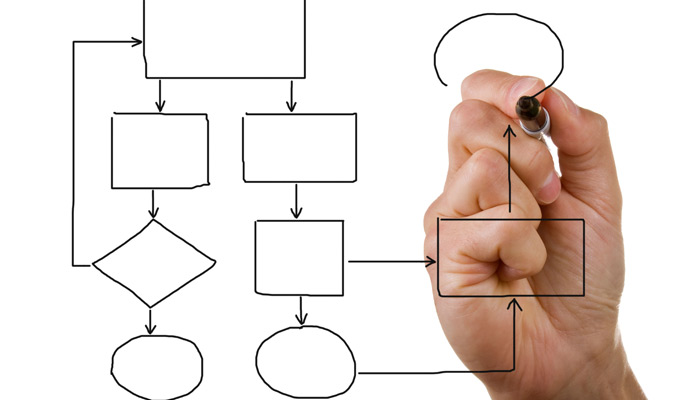Liberate Your Team with Clearer Processes
How the right type of structure frees your employees from rework and hassles.
Ask the members of any team if they want to institute better processes, and be prepared for them to roll their eyes. “‘Better processes’ means ‘more bureaucracy,’” someone will mutter. But ask that same team how much they enjoy doing projects the hard way — duplicating efforts, scrambling to meet deadlines when someone drops the ball, or bearing the brunt of customer fury — and you can expect the floodgates to open.
Why do people love to hate “process” but rail against disorganization? It is because most people associate processes with checklists, forms, and rules — the overseer breathing down their necks. Not surprisingly, leaders wanting to foster innovation and creativity are reluctant to institute such rigid controls and procedures.
In one sense, this aversion to processes is justified. Historically, formal procedures have been used to maintain control, not to simplify work. Process engineers can get carried away with forms and spreadsheets. However, a culture of “winging it” can be just as frustrating. In their 2011 book, The Progress Principle: Using Small Wins to Ignite Joy, Engagement, and Creativity at Work, Harvard professor Teresa Amabile and developmental psychologist Steven Kramer show that employees are least motivated on days when they face setbacks that inhibit their work. And sociologist Randy Hodson has found that coherent production processes are a key driver of trust in management. Hassles, exceptions, and “gotchas” increase stress, sap the feeling of progress, and force your team to fight the same fires over and over. Even worse, winging it tends to erode safety and quality, and increase the risk of ethical drift.
At their heart, effective processes are not about adding red tape — they are about enabling “flow.” According to management thinker Eli M. Goldratt, the real innovation behind Ford’s production lines, the Toyota Production System, and “lean” production is the shift from managing resource efficiencies in isolation to managing the flow of value generated by a system. Wherever there is an activity that happens repeatedly in your business, there is a potential flow. As a leader, you have the choice to leave this flow to chance, to control it, or to channel it.
At their heart, effective processes are not about adding red tape — they are about enabling “flow.”
Think of a river. If the banks are not strong and defined, the river dissipates across the countryside and has little force. This is like the operation in which employees are given little guidance, and whose efforts meander or collide. Another river may have locks that strictly regulate how much water can flow when and where. This is a company that tries to control every step every employee takes every day. The entire system is rigid and slow, because management can never keep up with the exceptions and re-prioritizations, and employees’ time is consumed by filling out forms and following procedures.
By contrast, a company with effective processes is like a river with strong banks. People’s attention and energy are channeled where they will have the most impact. The work environment, habits, tools, and methods guide people into doing things right the first time, based on a continually evolving set of shared best practices. No locks are required: Instead, employees are liberated to focus their creativity on developing new best practices, delighting customers, noticing changes in the competitive landscape, or tackling their company’s next moon shot.
Designing processes this way involves looking at how work naturally gets done and where simple structures can increase the throughput of value — much the way Japanese gardeners will design the paths in a garden after seeing where people walk. There are several approaches that incorporate this idea of flow, including Goldratt’s “theory of constraints” (and its project-based counterpart, “critical chain”), agile project management, and lean production’s “pull-based” scheduling. Whatever method you choose, here are three core ideas that I’ve found lead to the biggest breakthroughs:
• Make sure everyone sees the big picture. When people focus on efficiency in one part of a process, they suboptimize the system as whole — because they don’t weigh the impact of their actions on downstream groups or on the customer. To improve the flow, ensure everyone understands how their work fits together and how to prevent downstream defects through clearer handoffs, giving other departments sufficient lead time, and prioritizing based on overall goals.
• Love your bottlenecks. As Goldratt has shown, every flow has a capacity constraint — a “Herbie.” Instead of blaming your bottleneck, treat it as scarce resource whose capacity should never ever be wasted. Does it receive top-quality inputs from other groups? Is it ever left idle? Do you squander capacity by constantly switching priorities? A meta-analysis of Goldratt’s methods found companies reduced lead times by 75 percent and improved on-time performance by 50 percent.
• Do the right things more reliably. As management theorists W. Edwards Deming and Joseph Juran have shown, variability kills quality. Your team may produce excellent work most of the time, but if it is inconsistent, people will be forced to waste time checking to ensure no one drops the ball. Did you call the client with the update? Should I? You can reduce workload and increase the psychological experience of flow by identifying a few best practices and making them into solid habits.
What flows do you need to master in your business? Launching apps? Integrating mergers? Hiring and retaining employees? Select one that will increase your firm’s competitive advantage, set a goal, and then support your team in using one of the methods above. Don’t wait until the fires are out — firefighting is a symptom of poor processes. Instead, dedicate small chunks of time to improvement, chipping away at the biggest time wasters first. A Pareto chart can help you rank problems by frequency or cost. Wherever possible, listen to your team and adopt their recommendations, but insist on rapid feedback so they learn which solutions work. In the end, working on processes in a collaborative way is one of the fastest, most effective vehicles for building engagement and translating values into action.



